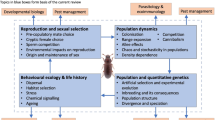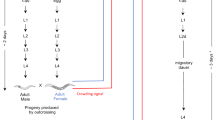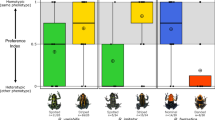Abstract
We report the existence of postmating but prezygotic reproductive isolation within flour beetles of the genus Tribolium. Specifically, when a female of either T. castaneum or T. freemani is paired simultaneously with both a conspecific and a heterospecific male, virtually all of the offspring are sired by the conspecific male. In contrast, when a female of either species is paired only with a heterospecific male, she produces near normal numbers of offspring. Mate choice experiments rule out the possibility that premating reproductive isolation accounts for this phenomenon. A number of different mechanisms could explain this phenomenon of postmating but prezygotic reproductive isolation.
Similar content being viewed by others
Article PDF
References
Bella, J L, Butlin, R K, Ferris, C, and Hewitt, G M. 1992. Assymetrical homogamy and unequal sex ratio from reciprocal mating-order crosses between Chorthippus parallelus subspecies. Heredity, 68, 345–352.
Brownlee, A, and Sokoloff, A. 1988. Transmission of Tribolium castaneum (Herbst) mutants to T. castaneum-T. freemani (Hinton) hybrids (Coleoptera: Tenebrionidae) J Stored Prod Res, 24, 145–150.
Butlin, R. 1987. Speciation by reinforcement. Trends Ecol Evol, 2, 8–13.
Butlin, R. 1989. Reinforcement of premating isolation. In: Otte, D. and Endler, J. (eds) Speciation and Its Consequences, pp. 158–179. Sinauer Press, Sunderland, MA.
Charlesworth, B, Coyne, J A, and Barton, N H. 1987. The relative rates of evolution of sex chromosomes and autosomes. Am Nat, 130, 113–146.
Coyne, J A. 1992. Genetics and speciation. Nature, 355, 511–515.
Coyne, J A. 1993. The genetics of an isolating mechanism between two sibling species of Drosophila. Evolution, 47, 778–789.
Coyne, J A, and Orr, H A. 1989. Patterns of speciation in Drosophila. Evolution, 42, 362–381.
Dobzhansky, Th. 1937. Genetics and the Origin of Species. Columbia University Press, New York.
Dobzhansky, Th. 1940. Speciation as a stage in evolutionary divergence. Am Nat, 74, 312–321.
Dobzhansky, Th. 1970. Genetics and the Evolutionary Process. Columbia University Press, New York.
Grant, B. 1983. On the relationship between average copulation duration and insemination reaction in the genus Drosophila. Evolution, 37, 854–856.
Grimaldi, D, James, A C, and Jaenike, J. 1992. Systematics and modes of reproductive isolation in the holarctic Drosophila testacea species group (Diptera: Drosophillidae). Ann Entomol Soc Am, 85, 671–685.
Hewitt, G M, Mason, P, and Nichols, R A. 1989. Sperm precedence and homogamy across a hybrid zone in the alpine grasshopper, Podismapedestris. Heredity, 62, 343–353.
Hinton, H E. 1948. A synopsis of the genus Tribolium MacLeay, with some remarks on the evolution of its species-groups (Coleoptera: Tenebronidae). Bull Ent Res, 39, 13–55.
Howard, D J. 1993. Reinforcement: the origin, dynamics and fate of an evolutionary hypothesis. In: Harrison, R. G. (ed.) Hybrid Zones and the Evolutionary Process, pp. 118–142. Oxford University Press, Oxford.
Howard, D J, and Gregory, P G. 1993. Post-insemination signalling systems and reinforcement. Phil Trans R Soc Lond B, 340, 231–236.
Juan, C, Vazquez, P, Rubio, J M, Petitpierre, E, and Hewitt, O M. 1993. Presence of highly repetitive DNA sequences in Tribolium flour-beetles. Heredity, 70, 1–8.
Littlejohn, M J. 1981. Reproductive isolation: a critical review. In: Atchley, W. R. and Woodruff, D. (eds) Evolution and Speciation Cambridge University Press, Cambridge.
Mayr, E. 1963. Animal Species and Evolution. Harvard University Press, Cambridge, MA.
Muller, H J. 1942. Isolating mechanisms, evolution and temperature. Biol Symp, 6, 71–125.
Park, T. 1933. Studies in population physiology. II. Factors regulating initial growth of Tribolium confusum populations. J Exp Zool, 65, 17–42.
Park, T. 1937. The inheritance of the mutation ‘pearl’ in the flour beetle Tribolium castaneum Herbst. Am Nat, 71, 143–157.
Park, T, Leslie, P H, and Mertz, D B. 1964. Genetic strains and competition in populations of Tribolium. Phys Zool, 37, 97–161.
Paterson, H E H. 1978. More evidence against speciation by reinforcement. S Afr J Sci, 74, 369–371.
Patterson, J T. 1946. A new isolating mechanism in Drosophila. Proc Nat Acad Sci USA, 32, 202–208.
Shrode, R R. 1960. Evidence that mating is random in T. castaneum. Tribolium Inf Bull, 3, 15–16.
Sokoloff, A. 1974. The Biology of Tribolium, 2. Clarendon Press, Oxford.
Thornhill, R, and Alcock, J. 1983. The Evolution of Insect Mating Systems. Harvard University Press, Cambridge, MA.
Wade, M J. 1976. Group selection among laboratory populations of Tribolium. Proc Nat Acad Sci USA, 73, 4604–4607.
Wade, M J. 1977. An experimental study of group selection. Evolutional, 134–153.
Wade, M J, and Goodnight, C J. 1991. Wright's shifting balance theory: an experimental study. Science, 253, 1015–1018.
Wade, M J, and Johnson, N A. 1993. Reproductive isolation between two species of flour beetles, Tribolium castaneum and T. freemani: variation within and among geographical populations of T. castaneum. Heredity, 72, 155–162.
Walsh, N E, and Charlesworth, D. 1992. Evolutionary interpretations of differences in pollen tube growth rates. Quart Rev Biol, 67, 19–36.
Wu, C I, and Davis, A W. 1993. Evolution of postmating reproductive isolation: the composite nature of Haldane's rule and its genetic bases. Am Nat, 142, 189–212.
Author information
Authors and Affiliations
Rights and permissions
About this article
Cite this article
Wade, M., Patterson, H., Chang, N. et al. Postcopulatory, prezygotic isolation in flour beetles. Heredity 72, 163–167 (1994). https://doi.org/10.1038/hdy.1994.23
Received:
Issue date:
DOI: https://doi.org/10.1038/hdy.1994.23
Keywords
This article is cited by
-
Coexisting good neighbours: acoustic and calling microhabitat niche partitioning in two elusive syntopic species of balloon frogs, Uperodon systoma and U. globulosus (Anura: Microhylidae) and potential of individual vocal signatures
BMC Zoology (2022)
-
The resilience of reproductive interference
Evolutionary Ecology (2021)
-
Reproduction barrier between two lineages of bed bug (Cimex lectularius) (Heteroptera: Cimicidae)
Parasitology Research (2015)
-
Sperm competition and offspring viability at hybridization in Australian tree frogs, Litoria peronii and L. tyleri
Heredity (2010)
-
Speciation and Sexual Conflict
Evolutionary Ecology (2005)



